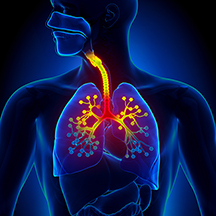Biomarkers & Respiratory Disease
Is a Cannabinoid Nasal Wash the Answer? Using Biomarkers to Detect Respiratory Disease
Aspirin-exacerbated respiratory disease (AERD), also known as Samter's Triad, is a chronic medical condition with three main features: asthma, sinus disease with recurrent nasal polyps, and a sensitivity to aspirin and other non-steroidal anti-inflammatory drugs (NSAID). It affects about one million people—about 30% of patients with asthma and nasal polyps have AERD. It can develop suddenly in adulthood, and symptoms include repeated sinus infections and the loss of one's sense of smell.
"People may not realize they have this disease," says otolaryngologist Joshua Levy, assistant professor of otolaryngology at Emory, who specializes in rhinology and sinus surgery at Emory Sinus, Nasal & Allergy Center and is director of resident research. "It's progressive, which is another reason it's difficult to diagnose. You can wind up in the hospital after taking one aspirin. It can be quite dramatic, causing life-threatening airway issues."
The reaction can be stimulated by aspirin, NSAIDs "basically any over the counter pain killer that is not Tylenol," says Levy. "The reaction tends to occur quickly and is severe enough that it's unlikely you would not be aware of it."

Levy and his team discovered that people who have AERD have a high expression of a cannabinoid receptor – one of the receptors activated by marijuana. "When we discovered this, we realized we could use this as a biomarker to identify the disease before patients end up in the hospital," Levy says. "Also, we found that activating this receptor improves the barrier within the airway, so it could be therapeutic as well."
The cannabinoid compound used to diagnose, and perhaps to treat, AERD would be similar to CBD oil in that it would activate the receptor but would not produce a psychogenic response, or a "high."
"Research related to CBD and cannabis has come to the forefront of many business discussions. This technology, in particular, comes to the table with a unique advantage—a diagnostic and potential treatment in one," says Catherine Murari-Kanti, licensing associate at Emory's Office of Technology Transfer.
Levy and collaborator Michael Koval, Emory professor of medicine, are doing research on tissue from AERD patients' polyps, so they have a human model for the condition in which to test the compounds. "The polyps are benign in that they don't kill you, but they greatly reduce quality of life and productivity," he says. "We have found that patients with nasal polyps suffer just as badly as people with coronary disease or end-stage renal disease."
The constellation of symptoms that accompany nasal polyps include nasal blockage, facial pressure, inability to breathe, loss of smell, sleep disruptions, and increased rates of anxiety and depression. Sinus disease also exacerbates inflammation in the lungs as well. "We can remove the polyps, and do," Levy says, "but oftentimes they regrow a year or two after removal. It's a huge limitation. I'd say about 40% of my patients experience this."
Many people with AERD also have a mild reaction when they drink alcohol, beer, wine, or liquor. "They get short of breath, their face flushes, their nose runs," Levy says. "We don't know why."
People diagnosed with AERD can avoid pain killers, which will "keep them from having acute issues, but not prevent debilitating baseline symptoms" he says.
He envisions that, once people find out they have AERD, at an early stage they could use the non-psychogenic cannabinoid compounds in a nasal rinse bottle, such as a neti pot, to rinse their nasal passages and topically activate the relevant receptors. "It's a local system, and could prevent progression of the disease, which permanently changes nasal passages and airways over time," Levy says.
"The big thing for me is improved control of this disease long term," he adds. "Repeated surgery is the standard of care we have now. I think we can do much better for these patients, if we identify them sooner."
Read our technology brief
Techid: 18109